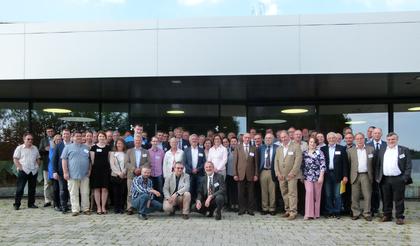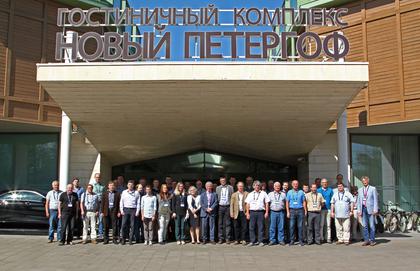Work Package 6
Science cooperation with XCELS in the field of high power laser research
Work Package Lead: Catalin Miron
catalin.miron@eli-laser.eu
Extreme Light Infrastructure Delivery Consortium International Association, Brussels (Belgium)
Russian partner: Institute of Applied Physics RAS, Nizhniy Novgorod (Russia)
Other partners: Commissariat à l'énergie atomique et aux énergies alternatives LIDyL, Saclay (France)
Objectives:
- To identify and map the research interests and needs of EU and Russian partners for scientific cooperation in the XCELS project;
- To work out measures and action plans to foster joint research projects towards the implementation of the project;
- To jointly develop and refine international standards for access, user policy, and governance of future large laser facilities;
- To undertake, from a combined EU and Russian perspective, foresight activities to identify the scientific and technological opportunities, user needs and political support for future laser facilities of the 100PW class. This includes the identification of synergies and complementarity between XCELS and international laser facilities in order to sharpen their respective scientific profiles and uniqueness.
- To explore legal and practical models for the future operation of XCELS as an integral part of the fabric of large European laser infrastructures.
These objectives shall be achieved through the establishment of close interactions between XCELS and
- national European laser research infrastructures
- European networks of laser research infrastructures (LASERLAB-EUROPE)
- the European ESFRI project “Extreme Light Infrastructure” ELI
- other emerging international laser projects
- the IUPAP International Committee on Ultra-high Intensity Lasers ICUIL
Task 6.1: Identification of key technological issues in construction and exploitation of 100PW-class lasers
The highest level of the pulse power of the laser radiation available today is below 2 PW. The XCELS project aims to create and use a laser system with the peak power of 200 PW. The planned jump by two orders of magnitude is ambitious and at the technological limit of existing laser amplification schemes. Most promising are two different approaches, both of which use the so called chirped pulse amplification (CPA) technique: The first one is based on a laser amplification population-inverted crystals of titanium-doped sapphire (Ti: Sa), with the maximum currently available aperture of about 20 cm of the active medium. The second approach is based on the parametric chirped-pulse amplification (OPCPA) in wide-aperture nonlinear optical crystals KD*P with a cross-section of up to 30 cm. Among the leaders in the development of the first approach are French laboratories (e.g. LULI-CEA), working on the Apollon-10 laser project with a peak power of 10 PW. Among the leaders in the OPCPA approach are Russian scientists (IAP), working on the creation of complex PEARL 10. The XCELS project is a continuation of the work on PEARL 10, including a 12-channel laser system with a capacity of 15 PW each.
In addition, each of the three centers of ELI in the Czech Republic, Romania and Hungary will also be equipped with laser systems with capacities between 2 and 10 PW, employing a wide range of amplifier technologies, pulse energies, and repetition rates. The ELI lasers are being built through contracts and/or close collaborations with world-leading industrial suppliers as well as research laboratories.
Thus, the collaboration ELI-IAP-CEA comprises already a substantial fraction of existing expertise on the technology of laser sources beyond 10 PW. Based on that, task 6.1 will initiate a broader European cooperation to address common technological challenges on the way towards 100PW class lasers. It will organize at least two workshops, the first of which will be held at the IAP and the second at the CEA. Results of these workshops will be deliverables of the WP6.
Task 6.2: Identification of novel applications of Exawatt laser sources
The laser system XCELS with the sub-Exawatt power will be a unique tool for studying new physical phenomena at the interface of strong-field physics and high-energy physics. An international network of users will emerge in the future around XCELS to create a program of experimental research and to participate in performing experiments and interpreting their results. To arrive at such user network, an early guided cooperation of researchers working on scientific applications of Exawatt laser radiation is indispensable. Currently, this community is just beginning to emerge, based on the prospect of near-future 10PW research opportunities (ELI, APOLLON-10 and PEARL-10), and stimulated by concepts for next-generation projrcts as proposed by ICUIL and IZEST. The CREMLIN project shall contribute to further development of this community in Europe and attract new researchers and young scientists to the topic of extreme light.
TASK 6.2 shall initiate this process with an international meeting (Workshop A) dedicated to novel applications of Exawatt laser sources with particular emphasis on research opportunities provided by XCELS, under the auspices of the project participants IAP, CEA and ELI, and with substantial partcipation of ICUIL, IZEST, LASERLAB-EUROPE and others. The meeting is scheduled to take place in Russia in the summer of 2016 with about 60 participants. A significant part of the costs will be taken by IAP, which is one of the in-kind contribution of IAP in the project. Materials of this workshop, which are deliverables on this task, are planned to be published in a special issue of an international scientific journal.
Task 6.3: Internationalisation, access and user policy, governance of laser user facilities
According to requirements to Russian mega-science projects, XCELS should be built as an international user facility with an essential contribution of foreign partners to its construction and operation. Up to 15% of overall cost is supposed by the XCELS roadmap to be received from abroad at the stage of construction, presumably as in-kind contribution in the form of laboratory equipment. At the operation stage, foreign partners will provide financial contribution in the amount proportional to the used XCELS source operation time. Starting from the prototyping stage through the construction stage to the operation stage, XCELS will have an International Advisory Committee with representatives of foreign agencies and labs that are interested in conducting research at XCELS.
The European Commission, particularly through its Research Infrastructure Networks and ESFRI projects, has developed over the last decades a large portfolio of tools and best practices for the governance and operation of large research infrastructures offering access to the international user community. Selecting from such portfolio the best elements is a unique and individual challenge for any research infrastructure and depends critically on the individual circumstances, especially when unprecedented technical specifications are involved as in the case of XCELS.
Therefore, the goal of task 6.3 is to help IAP to establish fundamentals of international access, user, and governance policy for XCELS. This will be done in expert round table discussions and/or workshops, including representatives of European research centers hosting large-scale user facilities both in laser physics and high-energy physics and in close connection with WP2. It is desirable to conduct the workshop at the premises of one of such centers to be acquainted with its operation and governance style. The deliverable will be a foresight document describing fundamentals of international access, user, and governance policy for XCELS.
Task 6.4: Expert round table on legal, practical, political and financial issues towards a future operation of XCELS as a pan-European RI
A particular feature of the project XCELS is that it is complementary to the European research infrastructure ELI, which is one of the largest projects on the ESFRI road map. ELI is now at the stage of implementation with the construction of three new research centers in the Czech Republic, Hungary and Romania. Construction of a fourth center of ELI, which should host the world's most powerful Exawatt-class laser facility, is currently being postponed. The process towards realization of this pillar will be resumed after the enormous challenges in implementing the three existing pillars have been largely mastered, given their unprecendented technical specifications, unique financing model for construction and future joint governance and operation under an European Research Infrastructure Cornsortium ELI-ERIC.
The Russian project XCELS, on the other hand, was deliberately designed with characteristics similar to the planned fourth center of ELI, and with the goal in mind to bring together the EU and Russia to create a single pan-European infrastructure ELI + XCELS, which will be based on the coordinated activity of 4 centers. The vision is that such a union might open up a opportunity for the EU to fully implement the project ELI without attracting significant amounts of European funding, and for Russia to become a full partner of the European fabric of reasearch infrastructures in the laser sector.
While such scenario is not inconceivable it will be under the sole control of the legal body in charge of ELI, most likely the future ELI-ERIC, to decide upon the site and technology of its fourth pillar. Still, and in view of this situation, it is important for the present task exploring scenarios and conditions under which XCELS can, in a more general way, be brought into the European Research Area and its laser infrastructures, and eventually become its equal member.
This should be the main topic of discussion at the round table, which is scheduled by task 6.4. Such a meeting –in close exchange with the horizontal platform WP2- is planned for the third year of CREMLIN with an invitation of key experts and scientific policy makers from the EU and the Russian Federation. The workshop will be followed by a foresight document describing legal, practical, political and financial issues towards a future operation of XCELS as part of the European Research Area.
Task 6.5: Workshop on involvement of European industry in XCELS project
Involvement of European industry in the XCELS project is supposed to be two-fold. Firstly, construction of XCELS will require a lot of components and instrumentation that may be delivered on the competitive base by European vendors of laser, optics, electronics and diagnostic equipment. On the other hand, laser technologies that are developed in the frame of XCELS may be of interest for high-tech companies as innovative products. As an example, collaboration between IAP and Thales Optronics (world leader in commercial Petawatt lasers) around XCELS has been formalized recently by an MoU. Having in mind a beneficial nature of such cooperation for the Russian and European sides, we propose a special workshop in close connection to the innovation activities in WP8 as the Task 6.5 that will widen the circle of foreign companies engaged in construction of XCELS and commercialization of its emerging technologies. Report to EC and series of MoUs following this workshop will constitute the deliverable of this task.





